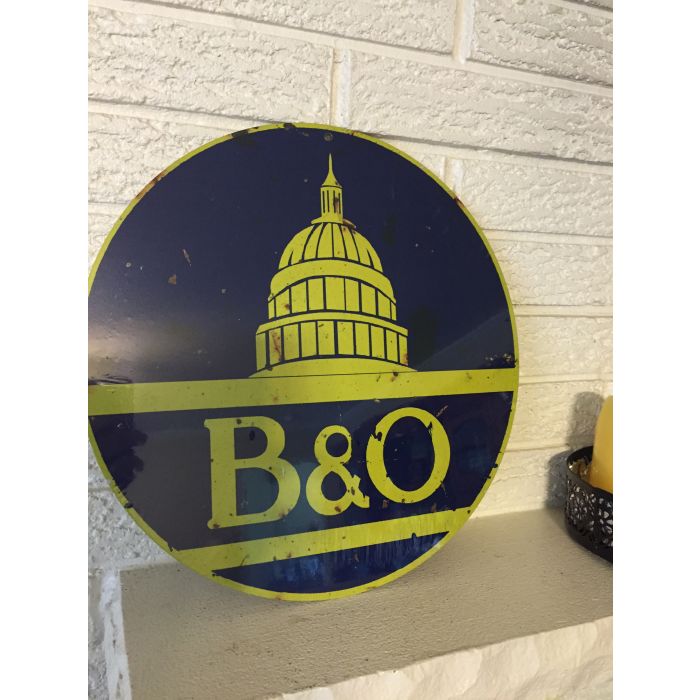Baltimore and Ohio Capital Logo Round Aluminum Sign New DL
$26.95
In stock
SKU
000065
Baltimore and Ohio Capital Logo Round Aluminum Sign NewAluminum Sign . Ready for hanging in that Railroad Room. Size 14" round. Picture shows item in Shrink Wrap.
The Baltimore and Ohio Railroad (reporting mark BO) was the first common carrier and Class I railroad in the U.S. as well as one of the oldest. During its peak years, the railroad extended as far east as Staten Island New York and as far west as Illinois. Most surviving trackage is operated by CSX Transportation; trackage on Staten Island is operated by the Staten Island Railway as a branch of the New York City Transit Authority.[1]
From WIkipedia
The Baltimore & Ohio Railroad (B&O) was not the first railroad in the U.S., but it was the first common carrier railroad and the first to offer scheduled freight and passenger service to the public. The most important U.S. seaports in the early 1800s were Boston, New York City, Philadelphia, Baltimore, and Charleston, South Carolina.[2][3] Baltimore had an advantage in being farther inland than the others (and therefore closer to many markets), being located almost at the head of navigation on Chesapeake Bay, the estuary of the Susquehanna River. New York gained an advantage in 1825 with the opening of the Erie Canal, permitting navigation as far as Lake Erie, and in 1826 the commonwealth of Pennsylvania chartered a system of canals to link Philadelphia with Pittsburgh. Baltimore responded to the competition of the other cities by chartering the B&O Railroad on February 28, 1827. The B&O was to build a railroad from Baltimore to a suitable point on the Ohio River.[2][4]:17,75[5]
Cornerstone of the B&O laid
The history of the Ann Arbor Railroad (AA) began with two companies organized in 1869 and 1872 to build a railroad between Toledo, Ohio and Ann Arbor, Michigan, approximately 45 miles (72 kilometres). The Panic of 1873 killed one of those two companies; it took another 20 years and 12 companies, most of them named Toledo, Ann Arbor & something, for the railroad to reach the eastern shore of Lake Michigan at Frankfort, Michigan. (The Toledo-Frankfort line was the railroad's sole route until the 1960s, when it acquired its only branch, a 4 mi (6.4 km) New York Central Railroad remnant from Pittsfield to Saline, Michigan.) From Elberta, across a small inlet from Frankfort, the Ann Arbor operated train ferry lines to Kewaunee and Manitowoc, Wisconsin, and Menominee and Manistique, Michigan. The AA was incorporated in 1895 as a reorganization of the Toledo, Ann Arbor and North Michigan Railway.[1][2]
The Detroit, Toledo & Ironton Railway (DT&I) obtained control of the AA in 1905 but sold its interests in 1910. In 1911 the AA purchased all the capital stock of the Manistique & Lake Superior Railroad (M&LS), which extended north from the Manistique, Michigan, to connections with the Duluth, South Shore & Atlantic Railway and the Lake Superior & Ishpeming Railroad.[1]
In 1925 the Wabash Railroad, which was controlled by Pennsylvania Railroad (PRR) interests, acquired control of the AA. By 1930 it held more than 97% of AA's stock. AA was in receivership from December 4, 1931, to January 1, 1943 but did not reorganize.[1] Never a major passenger carrier, AA discontinued its last passenger train in 1950 and gave its to full attention to freight service, which was largely made up of through freight using the Lake Michigan ferries to bypass Chicago and take advantage of lower rates. The railroad was completely dieselized by 1951.[1] In 1963, the Wabash sold the AA to the DT&I (which was owned by the Wabash and the PRR). The M&LS and the connecting 100 mi (160 km) train ferry route were abandoned in 1968. In 1970 the Interstate Commerce Commission authorized abandonment of the ferry route between Frankfurt and Menominee (80 miles (130 kilometres)) and the facilities at Menominee.[1]
Chicago
Mackinaw mackinac st ignace Houghton Grand Rapids Warren Sterling Heights Lansing Ann Arbor Flint Dearborn Livonia Westland Troy Westland Farmington Hills Kalamazoo Southfield St. Clair Shores Novi Battle Creek Saginaw Roseville Mackinaw mackinac st ignace Houghton Grand Rapids Warren Sterling Heights Lansing Ann Arbor Flint Dearborn Livonia Westland
Baltimore and Ohio Capital Logo Round Aluminum Sign NewAluminum Sign . Ready for hanging in that Railroad Room. Size 14" round. Picture shows item in Shrink Wrap.
The Baltimore and Ohio Railroad (reporting mark BO) was the first common carrier and Class I railroad in the U.S. as well as one of the oldest. During its peak years, the railroad extended as far east as Staten Island New York and as far west as Illinois. Most surviving trackage is operated by CSX Transportation; trackage on Staten Island is operated by the Staten Island Railway as a branch of the New York City Transit Authority.[1]
From WIkipedia
The Baltimore & Ohio Railroad (B&O) was not the first railroad in the U.S., but it was the first common carrier railroad and the first to offer scheduled freight and passenger service to the public. The most important U.S. seaports in the early 1800s were Boston, New York City, Philadelphia, Baltimore, and Charleston, South Carolina.[2][3] Baltimore had an advantage in being farther inland than the others (and therefore closer to many markets), being located almost at the head of navigation on Chesapeake Bay, the estuary of the Susquehanna River. New York gained an advantage in 1825 with the opening of the Erie Canal, permitting navigation as far as Lake Erie, and in 1826 the commonwealth of Pennsylvania chartered a system of canals to link Philadelphia with Pittsburgh. Baltimore responded to the competition of the other cities by chartering the B&O Railroad on February 28, 1827. The B&O was to build a railroad from Baltimore to a suitable point on the Ohio River.[2][4]:17,75[5]
Cornerstone of the B&O laid
Write Your Own Review

